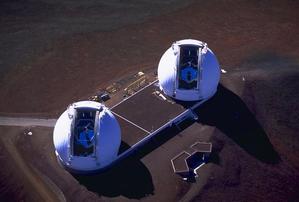Glossary term: Infrared Astronomy
Description: Infrared astronomy is a branch of astronomy that looks at infrared light. It is more sensitive to cool objects than observations in visible light and can observe very distant galaxies whose light has been redshifted a lot. Infrared observations are less affected by extinction and can thus see deeper into interstellar clouds of gas and dust.
Molecules in Earth's atmosphere absorb much of the infrared light coming from space and thus infrared astronomy on the ground is done mostly in wavelength ranges where this absorption is lower. Both Earth and its atmosphere radiate in the infrared so special techniques are required to remove this background radiation. For infrared radiation with longer wavelengths, this background plus atmospheric absorption makes observing on the ground almost impossible. As a result many infrared observations are carried out using space telescopes. However, for the longest infrared wavelengths ground-based observations are possible from very dry sites. This is typically called submillimeter astronomy.
Related Terms:
- Electromagnetic Radiation
- Infrared (IR)
- Infrared Telescope
- Redshift
- Interstellar Extinction
- Submillimeter Astronomy
See this term in other languages
Term and definition status: This term and its definition have been approved by a research astronomer and a teacher
The OAE Multilingual Glossary is a project of the IAU Office of Astronomy for Education (OAE) in collaboration with the IAU Office of Astronomy Outreach (OAO). The terms and definitions were chosen, written and reviewed by a collective effort from the OAE, the OAE Centers and Nodes, the OAE National Astronomy Education Coordinators (NAECs) and other volunteers. You can find a full list of credits here. All glossary terms and their definitions are released under a Creative Commons CC BY-4.0 license and should be credited to "IAU OAE".
Related Media
Hubble Space Telescope over Earth
Credit: NASA/ESA credit link
License: CC-BY-4.0 Creative Commons Attribution 4.0 International (CC BY 4.0) icons
Keck Telescopes
Credit: NASA/JPL credit link
License: PD Public Domain icons










